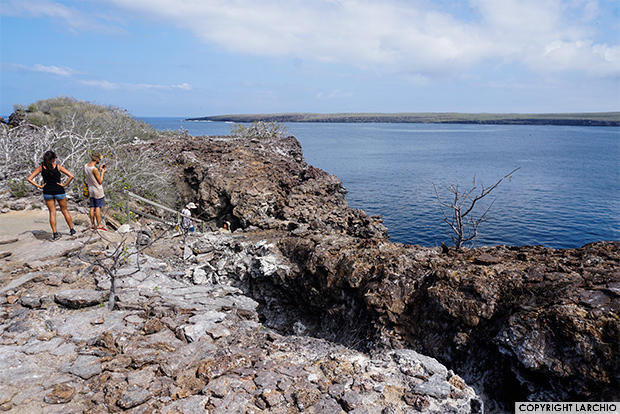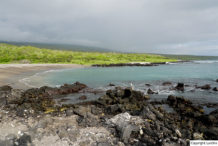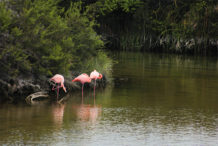Galapagos Travel Guide
We are the best rated Galapagos local agency. Take a trip with us!. Galapagos Travel Guide.
A trip to this captivating Galapagos archipelago lives up to dreams of a sheltered spot removed from the common troubles of society. The air is are usually bright and sunny, along with the ocean winds generate that appropriate air environment that can automatically relaxes the body. The ocean is an ever-welcoming turquoise blue, matched by very long sandy beaches of amazingly bright, pink, dark and green. You will find crystal coves and protected mangrove lagoons, and also magnificent cliffs and caves.
When is the best time to see the Galapagos?
The Galapagos Islands, found in the Pacific Ocean, about a thousand kilometers (600 miles) west of Ecuador, have a unusual weather conditions, warm and semi-arid, with an incredibly hot and comparatively wet season coming from January to May, along with a dry and cool time period, as well as foggy and misty, through July to November.
The landscapes of the Galapagos are dry, except in the bigger islands, which get far more considerable rain fall. As was already mentioned by Charles Darwin, who as we know observed the details of the species located in the isles, their weather conditions are less hot than an individual could be expecting from a place positioned close to the Equator, as a result of Humboldt Current, which usually reaches the location after running in the water west of Latin America. However, here the weather is varied from one year to another, because there are various sea flows which encounter or take turns in the region (there is also a warm current coming from Central America, which usually runs at a little length and is far more active in the periods El Niño), meaning that the climate is difficult to anticipate.
As stated, in these island destinations there’s two seasons: a warm season from January to May, having highest temperature ranges close to 29/30 °C (84/86 °F), as well as a reasonably cool period from July to November, known as Garua, with day temperatures about 24/25 °C (75/77 °F). In the latter, night-time temperatures remain suitable, close to 18/19 °C (64/66 °F), however there are frequently mists, which cause the condensation of small drops (known as garua from which the season takes its title), and the sky is frequently covered by low clouds (because of the thermal inversion produced by the low-temperature sea current). This interval is the least rainy of the entire year in shorelines and plains (since the Garua really doesn’t generate substantial rain accumulations), though away from the coast hills and mountains, there could be numerous real rains. The top peak is the Vulcan Wolf, 1,707 meters (5,600 feet) high, situated on Isabela Island.
It needs to be stated that rainfall is irregular, and may be a little more abundant in the years of El Niño. During the most severe El Niño years, for example 1982-83 and 1997-98, the climate of these Galapagos turns into fully tropical, having higher temperatures and also copious precipitation. In the years of La Niña, alternatively, the rains become more scarce, and there is a decrease in each air and sea temperatures.

When to go
Generally, the Galapagos may be traveled to all year round. However, the best time to travel to Galapagos, if you also want to swim and also take sunbathes, runs from February to May, because it is the most warm and sunniest, though there may be a number of downpours or thunderstorms in the afternoon.
The cool period, from July to November, is often recommended to explore nature, since it hardly ever rains on the plains and the climate is pleasurable, even though you have to take under consideration mists, haze and gloomy air. From September to November the sea could be a little rough, and this situation could bother those that are afflicted by movement sickness, during catamaran journeys from one island to the next.
What to pack
From December to May (warm cycle): light clothing, a lightweight sweatshirt for the evening hours, light raincoat or outdoor umbrella for rain showers; sun cap. For hiking in inland hills and the Vulcan Wolf, a bit more comfortable sweatshirt and raincoat, trekking shoes.
From June to November (cold period): light clothing, t-shirt or sweater and light coat for the night time.
For the reef, equipment for knee boarding, water shoes or rubber soled footwear.
The Galapagos is a year-round vacation destination, and nature-loving guests can expect to be shocked by the natural world in any calendar month. Still, there are two most important “seasons,” each of which have their draws and disadvantages.
High season, when tourists often drive occupancy levels to the max, is considered June through early September and December until mid-January. From June until November, the Humboldt Current brings colder, nutrient-rich water and (a bit) colder land temperature ranges. Average peaks can be close to 80 degrees. Winds and water are often a bit harder. Skies tend to be overcast, but rainfall is unusual. The change in water attracts fish and birds, making this an excellent moment to snorkel. Given the cooler water temps — sometimes in the low 60s– wearing a diving suit is a smart idea for swimmers aiming to keep in the water a bit longer. This is the mating season for the blue-footed boobies and waved albatrosses.
December through May, the air and water conditions are normally much more enjoyable, in the high 80’s, and seas are usually more calm. Light rain falls for a short period once a day, but the humidity is balanced with powerful sun rays. Sun-worshippers may be tested in February and March, when equatorial heat scorches the lava. Land vegetation blows up, with flowers everywhere. Many types of wild birds mate during this period, and sea turtle nesting also occurs.
El Nino, a weather trend, can upend weather-related forecasts, delivering a tropical feel to the atmosphere at unanticipated times.
Everyone of the Galapagos’ official visitor sites has something unique to offer, but travelers will have the ability to experience the best hits — sea lions, marine iguanas, lava lizards, endemic birds — about the majority of islands. Here are a couple of the most well-known spots.
Santa Cruz includes the Galapagos’ most populous “town,” Puerto Ayora, and is the island chain’s most important tourism hub. The island offers visitors the sole opportunity to experience the Galapagos’ interior high-lands, among a few areas to spot giant tortoises in their natural habitat. The Charles Darwin research center, a visit to which is included on every cruise, is also situated here.
South Plaza encompasses less than one-tenth of a mile in area and is one of the Galapagos’ smallest visitor websites. But the very small island, which was formed by volcanic uplift, makes a powerful impression with its color-changing ground vegetation, sea lions and colony of Galapagos land iguanas. The successful male iguanas could be seen standing guard in front of a cactus tree, waiting patiently to provide a hungry female with a part of prickly fruit.
Rabida: creates a bold statement when you arrive at its iron-rich red beach. Just inland is a brackish lagoon where visitors frequently visit flamingos, heads plunged submerged to spoon up crustaceans and algae using their bowl-like beaks.
Fernandina, the Galapagos’ youngest and westernmost island is best known for its not-infrequent volcanic eruptions, the latest of which was in 2009. It’s situated at the locus of this “hot spot” which created, and is still forming and creating, the Galapagos. As visitors step across lava flows and around the massive population of land iguanas, they gain a first-hand understanding of the ancestral roots of the islands.
Floreana is home of the Galapagos’ famous barrel-mailbox in Post Office Bay. For centuries, those visiting the famous Ecuadorian isles relied upon the unspoken duty of pirates and whalers to acquire letters to a planned destination. A mariner would render a dispatch, then pick through the pile for missives he could personally send (travel program allowing). The tradition continues today; cruise passengers visiting the site can leave and take postcards out of a (modern) barrel. Floreana is home to the Galapagos’ famous barrel-mailbox in Post Office Bay. For centuries, those visiting the famous Ecuadorian isles relied on the unspoken responsibility of pirates and whalers to Puerto Villamil and Nearby Regions – Isabela Island Cruises take in a variety of intriguing things around the massive island. Puerto Villamil is a small vent in the south east of the island, and it’s home to the clear majority of the island’s inhabitants. You can take pleasure in this fishing-community vibe, sample yummy freshly caught fish, participate with the cheerful kids, shop for souvenirs from the colorful stores, and admire the islets that dot the shore. Stroll along the boardwalk, resulting through mangroves, and see flamingos, gallinules, whimbrels, and much more. The Tortoise Breeding Center sits at the end of the boardwalk, helping conserve sea tortoises. The harbor is often filled with small luxury yachts and other sailing vessels, many of which take passengers on thrilling Galapagos cruises.
Isabela Island Cruises enable guests to find the natural beauty of the biggest island of the Galapagos. Straddling the Equator, Isabela Island is in the western portion of the Galapagos archipelago, close to the volcanic Galapagos hotspot that created the island collection. A lesser-visited area, it’s also among the most varied, and it’s no mean feat in an area that is already known for being among the most diverse areas on the planet.
Galapagos Facts
The estimated age of the islands is estimated between 4 and 10 million years. The Islands lie on the Nazca tectonic plate and are the plate’s main land mass. Intense heat caused by the plates being pushed apart contributes to eruptions which create new volcanoes and eventually form new islands (‘Hot spot’ theory. There have been around 13 eruptions in Galapagos in the previous 100 years.
GALAPAGOS CRUISES 2024
NEMO 2
| DEPARTURES | ITINERARY | AVAILABLE CABINS | SPACES | |
|---|---|---|---|---|
| There aren't available dates for the selected dates |
















